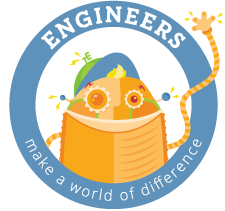Hands-on, Mathematics-Aligned Engineering Curriculum
The TeachEngineering mathematics-aligned activities featured here, by grade, support the Common Core Standards for Mathematics.
Select your math topic:
Exemplar CCSS Math-aligned TeachEngineering curriculum:
First-grade students are introduced to systems thinking and scale by working in teams to reassemble the separated pages of the Zoom picture book. They experience surprising changes in perspective and learn how engineers work together to examine projects very closely in order to notice details and di...
A unique activity for young learners that combines engineering and biology, students design an optimal environment for red wiggler worms in a compost bin.
Students determine the coefficient of restitution (or the elasticity) for super balls. Working in pairs, they drop balls from a meter height and determine how high they bounce. They measure, record and repeat the process to gather data to calculate average bounce heights and coefficients of elastici...
Create popsicles using the engineering design process! In this activity, students work to solve the problems of a local popsicle shop while learning how scientific and engineering concepts play a part in behind-the-scenes design.
Select your math topic:
Exemplar CCSS Math-aligned TeachEngineering curriculum:
Students drop water from different heights to demonstrate the conversion of water's potential energy to kinetic energy. They see how varying the height from which water is dropped affects the splash size. They follow good experiment protocol, take measurements, calculate averages and graph results.
Students design a temporary habitat for a future classroom pet—a hingeback tortoise. The students investigate hingeback tortoise habitat features as well as the design features of such a habitat. Each group communicates and presents this information to the rest of the class after they research, brai...
Students learn how engineers use solar energy to heat buildings by investigating the thermal storage properties of some common materials: sand, salt, water and shredded paper. Students then evaluate the usefulness of each material as a thermal storage material to be used as the thermal mass in a pas...
Students develop an understanding of how engineers use wind to generate electricity. Student teams build model anemometers to better understand and measure wind speed.
Select your math topic:
Exemplar CCSS Math-aligned TeachEngineering curriculum:
Students learn about convection, conduction, and radiation in order to solve the challenge of designing and building a small insulated cooler with the goal of keeping an ice cube and a Popsicle from melting. This activity uses the engineering design process to build the cooler as well as to measure ...
Students apply the concepts of conduction, convection and radiation as they work in teams to solve two challenges. One problem requires that they maintain the warm temperature of one soda can filled with water at approximately human body temperature, and the other problem is to cause an identical so...
Students learn about the role engineers and mathematicians play in developing the perfect bungee cord length by simulating and experimenting with bungee jumping using washers and rubber bands. Working as if they are engineers for a (hypothetical) amusement park, students are challenged to develop a ...
Students act as engineers to solve a hypothetical problem that has occurred in the Swiss Alps due to a natural seismic disaster. Working in groups, they follow the engineering design process steps to create model sleds that meet the requirements to transport materials to people in distress that live...
Select your math topic:
Exemplar CCSS Math-aligned TeachEngineering curriculum:
A hypothetical scenario is introduced in which the class is asked to apply their understanding of the forces that drive natural selection to prepare a proposal along with an environmental consulting company to help clean up an area near their school that is contaminated with trichloroethylene (TCE)....
Students apply their understanding of light polarization and attenuation to design, fabricate, test and refine their own prototype sunglasses that better reduce glare and lower light intensity compared to available sunglasses, and better protect eyes from UVA and UVB radiation. They meet the project...
Building on an introduction to statics, dynamics free-body diagrams, combustion and thermodynamics provided by the associated lesson, students design, construct and test their own rocket engines using sugar and potassium nitrate—an opportunity to apply their knowledge of stoichiometry.
Challenged with a hypothetical engineering work situation in which they need to figure out the volume and surface area of a nuclear power plant’s cooling tower (a hyperbolic shape), students learn to calculate the volume of complex solids that can be classified as solids of revolution or solids with...
TeachEngineering provides lesson plans and activities with math-focused worksheets and assessments to promote mathematical proficiency essential to K-12 youth. Our curriculum stresses the importance of understanding problems, using models and mathematical concepts to solve problems, and developing feasible arguments based on data. We hope you find these math-aligned engineering lessons and activities useful in your classroom!
Browse All Math-Aligned Engineering Curriculum



